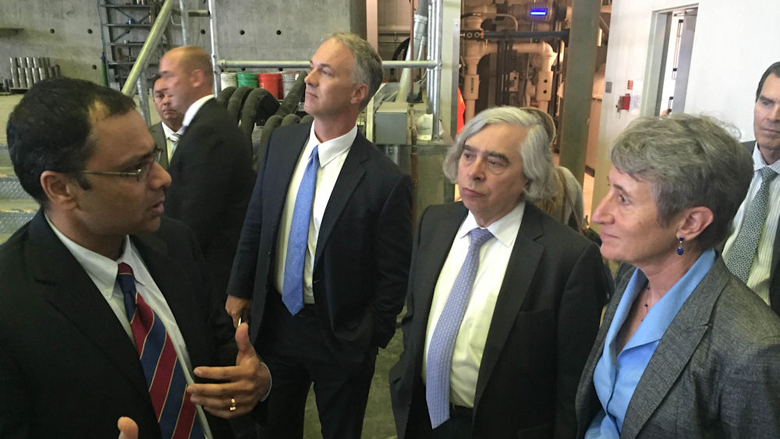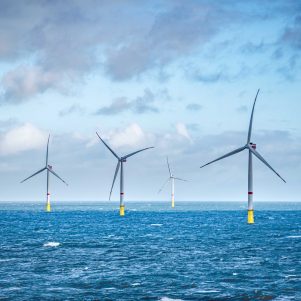Energy, interior chiefs talk up offshore wind power plans
By State House News Service | September 12, 2016, 7:01 EDT
 Rahul Yarala (left), director of the Wind Technology Testing Center, guided New Bedford Mayor Jon Mitchell (center), U.S. Energy Secretary Ernest Moniz (right), U.S. Interior Secretary Sally Jewell (far right), and other officials on Friday through the Massachusetts Clean Energy Center’s facility in Charlestown. [Photos: Antonio Caban/SHNS]
Rahul Yarala (left), director of the Wind Technology Testing Center, guided New Bedford Mayor Jon Mitchell (center), U.S. Energy Secretary Ernest Moniz (right), U.S. Interior Secretary Sally Jewell (far right), and other officials on Friday through the Massachusetts Clean Energy Center’s facility in Charlestown. [Photos: Antonio Caban/SHNS] BOSTON — Unveiled in Charlestown on Friday, an updated federal strategy for offshore wind development aims to develop 86,000 megawatts of power across the United States by 2050, support 160,000 jobs, and address 30 specific challenges facing the growing industry.
The strategy is in keeping with the thrust of a new Massachusetts law designed to procure 1,600 megawatts of offshore wind power here, primarily in the waters south of Martha’s Vineyard where energy companies have leased development rights from the federal government.
Energy Secretary Ernest Moniz and Interior Secretary Sally Jewell visited and toured the five-year-old Massachusetts Clean Energy Center’s Wind Technology Testing Center Friday to promote the strategy and recognize a wind farm off Block Island, Rhode Island, as the nation’s first offshore commercial wind source.
Federal officials say the Rhode Island wind farm is expected to start operating by the end of 2016 and produce 30 megawatts of power, enough to deliver electricity to 17,000 homes. Since 2010, the Department of Interior has issued 11 commercial leases for offshore wind development with the potential to generate as much as 14.6 gigawatts. The leases have been in the Atlantic where relatively shallow depths make offshore wind more feasible, Jewell said.
Jewell said a few factors contributed to the Bay State’s role in development of wind energy, including its electricity demand.
“Congratulations on being in a windy place with a high load and some really smart people,” Jewell said.
There is enough offshore wind energy potential in the United States for “roughly twice as much electricity as the country currently uses,” Moniz said.
“The U.S. resource is robust, abundant, and regionally diverse, allowing for offshore wind development to be located near load centers with some of the highest electric rates in the United States,” the report said.
New England has relatively high energy costs, a dynamic blamed in part on the lack of traditional fossil fuel energy sources nearby.
At the wind turbine testing center next to the Mystic River the Obama administration unveiled a new offshore wind strategy that calls for permitting wind farms up to 200 nautical miles from shore and at lesser density. The strategy calls for lowering the density from 5 megawatts per square kilometer to 3 megawatts per square kilometer.
Jewell said the Bureau of Ocean Energy Management has not yet awarded leases more than 50 nautical miles from the shore, which is part of the new strategy. Matthew Morrissey, vice president for Massachusetts at Deepwater Wind, said building offshore wind off the continental shelf would require further development of technology for floating the wind turbines rather than building them directly into the seafloor.
Jewell said the Interior Department would seek areas without conflicts with the fishing industry or others.
“We’re going to go to the areas that have the low-hanging fruit,” Jewell said at a press conference within the hangar-like Wind Technology Testing Center where two prototype turbines loomed over the room.
Jewell said the federal government would work to standardize the data it collects on potential sites for offshore wind development.
“It’s been a little bit more haphazard as we’ve been learning together,” Jewell said. She also said presidential declarations of national marine monuments – which protect those areas – can be crafted to exclude or include offshore wind, and a recent monument declaration off the coast of Hawaii specifically excluded wind generation in the area.
Offshore wind is far more developed in Europe where 3,230 turbines capable of generating more than 11,000 megawatts had been installed by the beginning of this year, according to the European Wind Energy Association.
While lacking a robust offshore wind industry, the United States has made progress on reducing carbon emissions. Dan Utech, President Barack Obama’s deputy assistant for energy and climate change, said greenhouse gas emissions are about 9 percent below 2005 levels and energy related emissions are 12 percent lower than in 2005.
On Tuesday, the Baker administration announced it had signed a letter of intent with DONG Energy, Deepwater Wind and OffshoreMV to lease the $113 million New Bedford Marine Commerce Terminal, a harbor-side facility built to support the offshore wind industry.
“We’re ready to be the center of this industry on the East Coast,” said New Bedford Mayor Jon Mitchell, who said the wind energy effort is “not dissimilar from the launching of the Space Program.”
At the Charlestown facility, machinery sought to wear down two prototype turbine blades, twisting and bending them repeatedly in the air in a process that takes about four months, according to Catherine Williams, spokeswoman for the Massachusetts Clean Energy Center. The two blades undergoing a life test were about 170 to 180 feet, according to a Department of Energy official.
Lauren Burm, public affairs manager for DONG Energy US Wind Power, told the News Service the Danish company, which is seeking to develop an area off Martha’s Vineyard, is currently deploying blades that are 600 feet long.
According to the strategy book released by the departments of Energy and Interior, cost reductions in offshore wind development should make the cost of a megawatt hour reach as low as $100 by 2030.
Jose Zayas, director of Wind & Water Power Technologies in the Energy Department, told the News Service natural gas currently costs about $50 per megawatt hour and solar costs about $70.
Although offshore wind requires power lines cabled to mainland locations, Zayas said offshore wind has relatively low transmission costs because it can be located near densely populated coastal areas, avoiding congestion within the nation’s energy grid.
“You can have it near the load center,” Zayas said.
While state officials did not play prominent roles at Friday’s event, U.S. Sen. Ed Markey praised the “leadership” of the Baker administration, expressed urgency in developing renewable energy to slow climate change, and sought to make a new slogan for Massachusetts catch on.
“We are the Saudi Arabia of offshore wind for the planet,” Markey said. The Malden Democrat also said without congressional action tax breaks for wind energy will phase out in 2019, and he and Rhode Island Sen. Sheldon Whitehouse have pushed for an extension of tax incentives to 2025.
The energy legislation signed by Gov. Charlie Baker requires utilities to obtain 1,600 megawatts of their power from offshore wind by the summer of 2027.
Morrissey said large renewable energy projects are unable to compete in the usual marketplace for electrical generators, which is driven by price.
“There has to be some guarantee of a customer,” Morrissey told the News Service. He said he would have a better idea of when Deepwater might reach the “steel in the water” construction phase for its area off Martha’s Vineyard after the Baker administration releases a request for proposals next June. Morrissey said Deepwater’s construction of the area would probably last two seasons.
House Speaker Pro Tem Patricia Haddad, who shares a Fall River upbringing with Moniz and lives in Somerset, told the News Service the speed of development of wind generation off the Massachusetts coast will depend largely on the development of regulations and the procurement process. She said Deepwater’s development off Block Island “really moved very quickly.”
As the U.S. looks farther out to sea for more wind generation, there will be new opportunities and challenges.
Thomas Brostrom, general manager of DONG US, told the News Service the wind is “stronger” further out to sea, but there are “logistical challenges,” including transporting workers out to the site and running transmission lines into the shore.
“I think the people who don’t like to see them would be very happy,” Haddad said of the prospect of developing wind farms further from the shore.
— Written by Andy Metzger and Michael P. Norton
Copyright State House News Service











